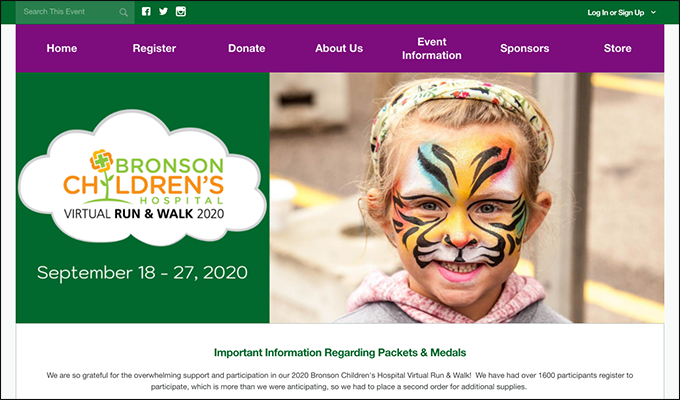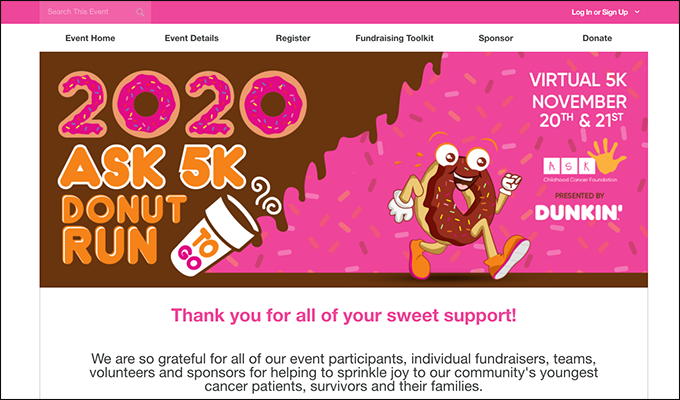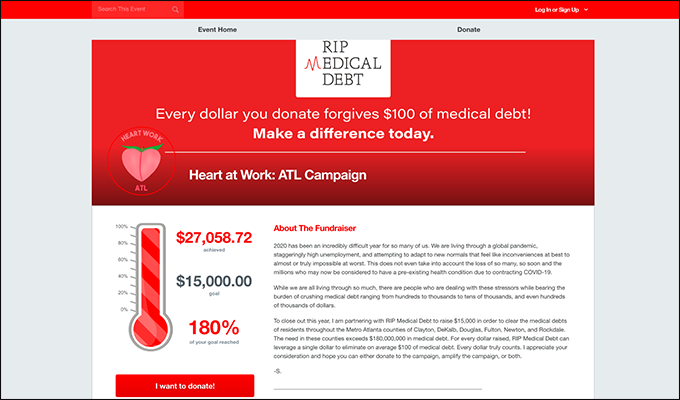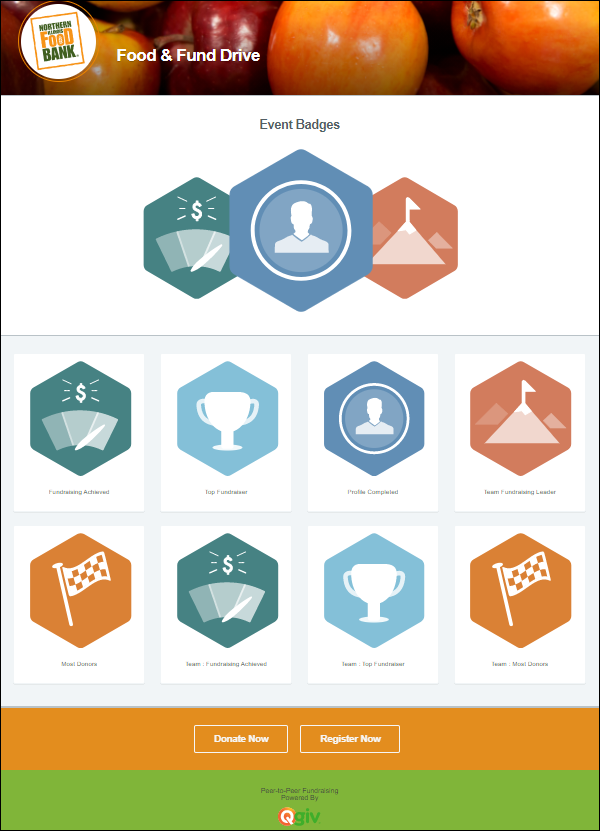Medical nonprofits and other healthcare organizations are changing the world. Whether your mission is to bridge technology gaps in healthcare or increase care mobility, organizations like yours are leaders when it comes to disease control and prevention, vaccinations, and other health-related challenges in a community.
This is why fundraising is crucial for medical nonprofit organizations. Because of the nature of your work, it’s important you have the necessary funds for research, support and staff, and awareness-building.
Peer-to-peer fundraising is a social fundraising tactic that not only helps you reach goals but also leverages the power of personal connections, which is often a motivator for medically-related donations. Because supporters are making fundraising appeals to their friends, family, and peers, it’s also a surefire way to raise awareness of your needs.
All great fundraising campaigns start with research, and you’ve come to the right place! In this comprehensive guide, we’ll explore the following topics:
- How Can Peer-to-Peer Fundraising Be Used For Medical Nonprofits?
- Peer-to-Peer Fundraising Tips for Medical Nonprofit Organizations
- Medical Nonprofit Organizations: Fundraising Examples
- Additional Resources
Empowering your supporters to fundraise on your mission’s behalf will not only increase funding for essential projects but also strengthen their relationships with your organization. Want to learn more? Let’s get started.
Master peer-to-peer fundraising by connecting with your incredible supporters. Download eBook
How Can Peer-to-Peer Fundraising Be Used For Medical Nonprofits?
Peer-to-peer fundraising can be extremely valuable, but it all depends on the passionate supporters you recruit and the resources and motivations you provide them.
When you communicate about your cause in ways that really resonate with people, you can better recruit enthusiastic participants to aid your peer-to-peer campaigns. Inspiration begets inspiration! These loyal supporters then inspire their networks to get involved, too, introducing your mission to new audiences.
Basic peer-to-peer planning looks like this:
1. Determine a goal, 2. Recruit volunteers, 3. Provide resources, 4. Share campaign pages, 5. Track progress]
Often, peer-to-peer fundraisers raise more money than your other donation forms. This is because, unlike general donation forms, peer-to-peer donors usually give not just to help out a good cause, but to also support a loved one.
Still not convinced peer-to-peer fundraising can help medical nonprofits? Here are some scenarios in which this type of campaign could benefit your organization:
- Raise money and awareness for an ongoing project. For example, a medical nonprofit might implement peer-to-peer fundraising every year to support a program dedicated to helping sick kids fulfill a “wish.”
- Continue the momentum of a capital campaign for a major project. For example, let’s say your medical organization is funding a new hospital building. Use peer-to-peer fundraising to continue collecting gifts even after the peak of the campaign is over.
- Garner excitement leading up to a larger event. For example, many nonprofits use peer-to-peer fundraising to generate participant support for walkathons or 5Ks.
- Increase awareness of relevant issues. For example, let’s say your medical organization is dedicated to providing vaccines to those who might not have easy access. A peer-to-peer fundraiser will not only help you fund this project but also raise awareness for those who might not have known this was a problem in the first place.
- Incentivize giving for a time-sensitive project. For example, peer-to-peer fundraising can be highly valuable for urgent needs such as emergency funds. This can help when storms hit and knock out the power at a hospital or when a global pandemic causes a shortage of supplies.
For a successful peer-to-peer campaign, you’re likely going to need the right software solution. This is more than just a simple online donation and event registration tool. Qgiv offers a peer-to-peer solution with customizable fundraising pages, gamification tools, and data analytics abilities.
5 Fundraising Tips for Medical Nonprofit Organizations
1. Plan The Basics
Planning a peer-to-peer campaign for your medical nonprofit can seem complicated at first. After all, you have to recruit participants, motivate them to fundraise for your mission, and plan an event that goes with it.
Start with the basics so you have a solid foundation to build on. This includes what your peer-to-peer campaign will entail, your fundraising goals, and the specific resources and tools you’ll need along the way.
Ask yourself these questions:
- Will this be a purely virtual, in-person, or hybrid event? This is important to consider, especially if your staff frequently interacts with medical patients or other immunocompromised individuals. For this reason, hosting a virtual event or at least including virtual elements within a hybrid event is a good idea. However, if this risk doesn’t apply to your organization, then an in-person event may be what you’re looking for.
- When and how long will the peer-to-peer campaign run? Set a start date and end date for the entire fundraising campaign. This way, your participants know how much they need to contribute to reach the fundraising goal by the end of the campaign. The last few days can be exciting as you near your goal, so use that time to inspire your participants to break records and fundraise even more!
- What is your overall goal, in terms of both fundraising and target action with the funds? Before the campaign begins, determine a fundraising goal and decide how exactly these funds will support your mission. It’s important to be as specific as possible so that no one is unsure of what exactly they’re giving to. For instance, let’s say your peer-to-peer fundraiser is intended to raise funds to open a new hospital clinic and provide more accessible healthcare. When supporters and peer-to-peer recruits know this going into the campaign, it’s much easier to solicit gifts because they’re motivated to complete the tangible goal.
- Is your main goal to raise donations, awareness, or both? This is important because your peer-to-peer strategy will differ depending on your main objective with this campaign. If it’s to raise donations, you might encourage your fundraisers to request donations from high-impact prospects like major donors. If it’s to raise awareness, you might create specific posts or provide photos for fundraisers to share when talking about your organization to friends and family.
For any fundraising campaign, looking at past data is valuable. Use your nonprofit database to evaluate past events and donor metrics to determine what elements worked in previous events and what could use improvement.

2. Build Your Peer-to-Peer Fundraising Website
Your website is the place supporters will go to get updates on the campaign, watch your fundraising progress, and learn about the impacts of their gifts. Since many donors are giving for the first time thanks to your peer-to-peer recruits, having an informative website is critical.
Leverage Smart Branding
Research shows that branding your fundraising website to your organization and mission can bring major benefits.
Studies say donations made on a branded giving form are, on average, 38% larger than contributions made through a generic PayPal page. And, supporters are almost 70% more likely to give again if a branded page was used the first time around.
Include your nonprofit mission statement and logo throughout your entire website, not just your giving form. Your website is the perfect place to introduce donors to your brand, especially since many of them might be giving for the first time.
This way, if they see your colors or logo on a different campaign or when you partner with a corporation, they’re more inclined to recognize and trust the project.
Incorporate Gamification
Your peer-to-peer website is not just a helpful tool for new donors— it’s also a core resource for your fundraising participants.
Your site should track current fundraising progress (for your overall goal and each individual) as well as host resources, like email templates or specific hashtags, that participants can use to improve their fundraising asks.
Another way to make your website more valuable is to use it to gamify your campaign! Gamification involves adding game mechanics to non-game situations. This adds a healthy level of competition and can make fundraising just as fun as playing a video game or sports.
Consider incorporating the following gamification elements to your peer-to-peer website:
- Teams and their fundraising progress. To motivate your recruits, group them into teams to compete for the most gifts solicited. The winning team can get a fun prize or social media shout-out at the end. As soon as fundraisers go on your website, they should be able to determine their team’s progress as well as others’, incentivizing them to work even harder.
- Digital badges on participant profiles. Along with fundraising progress for each individual/team, offer participants a way to display creative badges for different milestones. “Made First Fundraising Ask” or “Most Popular Social Media Post” are good badge ideas.
- Host a fundraising hub that centralizes all campaign progress. This can include individual fundraising progress, along with leaderboards that rank each individual or team. A creative way to show overall fundraising progress is with a fundraising thermometer. Feature this on your website so participants can check in on the campaign. The closer they are to a goal, the more motivated they’ll be to see it through!
Gamification is rising in popularity to keep up engagement during virtual events. Use these same tactics with your peer-to-peer fundraisers!
Leverage Social Media Connections
A valuable tool for your peer-to-peer campaign is social media. Because this type of fundraiser relies on the personal networks of your participants and supporters, social media plays a large role in raising awareness and making asks.
Make sure your peer-to-peer fundraising website supports social media fundraising by:
- Providing social media templates that work with Instagram, Facebook, X, and any other major platform.
- Displaying a hashtag that all social media posts should use.
- Offering ideas on how participants can leverage social media and its different media formats. For instance, you can encourage users to create videos with a certain theme and hashtag for TikTok.
- Creating a page dedicated to helping users fundraise on Facebook. Qgiv has a Facebook fundraiser integration that displays funds raised on Facebook in real-time.
In an average peer-to-peer fundraising campaign, 15-18% of donations are referred directly from Facebook. Don’t miss out on leveraging social media to your advantage.
3. Promote Your Event
To have success for any type of fundraiser, you need effective marketing. Luckily, peer-to-peer campaigns, by nature, have large marketing potential, especially since your recruits are focused on making asks and raising awareness for you.
However, there are some essential steps you also have to take to ensure your campaign recruits the best participants and inspires supporters to give.
Finding Participants
To get your peer-to-peer campaign off the ground, you’re going to need volunteer participants. But how can you find them?
Here are some tips you can use to find the best peer-to-peer recruits:
- Look at donor data to reach out to previous donors.
- Partner with a university or school and ask students to participate for volunteer hours.
- Reach out to other individuals who’ve shown support but haven’t donated themselves. This can be volunteers or those who have signed up for a newsletter.
Once you have a good number of volunteers to fundraise on your behalf, they can start as soon as your campaign does. Make sure to provide them with the necessary resources so that they can begin with confidence.
Choosing Your Marketing Channels
When it comes to promoting your peer-to-peer campaign, it’s more than just announcing it to your donors and current supporters. As the fundraiser progresses, you need to play an active role and ensure that recruits are still engaged and motivated.
These are the common marketing channels you’ll likely use:
- Email can be used to send mass announcements to all of your peer-to-peer participants. Remember to segment them from your general email recipients so that you don’t send irrelevant information to other donors. This is a great way to send fundraising progress updates and announce big milestones. You can even send email templates to fundraisers that they can use themselves when reaching out to others.
- Text marketing can be used to quickly relay campaign progress and reminders. Qgiv offers a mobile suite where you can not only send texts but also track the progress of your peer-to-peer campaign.
- Social media is another channel where you can provide consistent campaign updates. You can also take advantage of its different media formats to post fun promotional content. Consider posting photos and videos of your medical nonprofit aiding your community to inspire gifts. This is also a good way to raise awareness of your nonprofit mission.
Using more than one way to communicate and market your campaign is a good idea, especially since each person has their individual preferences. If they don’t check their email but scroll through Instagram, then you know for sure that your message still reaches them.
Impact Stories Vs. Privacy Laws
A common way that nonprofits market their peer-to-peer campaigns is with impact stories. For a medical organization, you might think that this is your best bet to resonate with prospects’ emotions and inspire gifts.
However, there are a few obstacles you’ll likely face when fundraising for medical causes.
For one thing, there are certain privacy guidelines and the Health Insurance Portability and Accountability Act (HIPPA) that prevent using your patients’ or specific community members’ stories to promote your organization. Sharing photos or using names is also not allowed.
Further, you have to be extra careful with your wording. For legal reasons, you can’t make broad statements like “your donations are helping fund a cure” on medical donation forms or any other type of marketing materials.
How can you work around these restrictions and still create compelling impact stories? Use these tips:
- Use stock photos to represent patients or use photos of staff.
- Create composite stories with general names and conditions.
- Be intentional with impact statements to avoid sweeping statements like “Thanks for helping us find a cure.”
Fundraising for your medical nonprofit may come with added considerations. However, that doesn’t mean that you can’t use impact statements altogether.
4. Engage Your Peer-to-Peer Participants
You have to remember that your peer-to-peer recruits are not professional fundraisers like you are. It’s not uncommon for them to lose steam as the campaign goes on, especially if it lasts weeks or months.
As we mentioned earlier, it’s up to you to provide progress updates and offer resources that not only help them make fundraising asks but inspire them to continue doing so.
Here are other ways you can keep participants engaged and motivated throughout the campaign:
- Prepare fundraisers as soon as they register. First, send all participants a welcome series introducing them to the fundraising tools. Show them how to customize their peer-to-peer page and help them make their first appeal. Explain to fundraisers that personal storytelling will help, and make sure they know how to add those elements to their fundraising pages. Qgiv offers customized welcome quests on our peer-to-peer fundraising platform.
- Ask fundraisers to set personal goals and provide consistent updates on their progress. These updates shouldn’t just go to you, but also the audience they’re requesting donations from. For example, they can use their goals to post videos saying “I’ve given myself to midnight tonight to raise X dollars to help fight cancer. I’m $50 away. Can you help me reach my goal?”
- Use email, a mobile texting suite, social media, and a fundraising hub to provide campaign updates and other additional resources. Encourage participants to share these updates on their own with their networks. This is also a great opportunity for fundraisers to share why they are raising funds for your medical nonprofit and tell their own story.
Throughout it all, your peer-to-peer participants should have a dedicated person to go to for help if they have questions or concerns. Assign a staff member or team to be the sole troubleshooter and respond to participants as soon as something comes up.
5. Keep The Momentum Going After Your Event
A big benefit of peer-to-peer campaigns is that your mission and cause are put at the forefront of multiple new audiences. Many of your peer-to-peer donors will likely be giving for the first time, as they only discovered your organization through one of your fundraising recruits.
However, meeting all these new people won’t amount to much if you don’t continue the momentum after the campaign is over!
It’s important that you plan your post-event communication strategy before the campaign begins. As soon as a gift is made, trigger your tools to send an appreciation email. This email should:
- Thank donors for the donation.
- Summarize impact.
- Reintroduce your organization and mission.
- Include other ways they can support your organization and links back to your main website.
An email like this is a great starting point for new donor relationships! Along with triggering your thank you emails, consider other components of a successful post-event communication strategy.
For example, if your event was in person, you might plan follow-up presentations of your peer-to-peer campaign during meetings or other in-person events. This will summarize the continued impacts of the campaign and show how supporter efforts are still making a difference.
If your event was virtual, you might follow up by sending a campaign survey. Create different surveys for participants and donors. Then, segment each group and send them out. This is also a smart way to gain some feedback on the virtual aspect of the event and provide future opportunities for improvement.
For more on how you can retain your peer-to-peer participants and donors between events, download our free e-book on this topic!
Medical Nonprofit Organizations Peer-to-Peer Fundraising Examples: Qgiv Clients
Bronson Children’s Hospital – Virtual Run & Walk

The Bronson Health Foundation is the charitable component of the Bronson Healthcare system. Each year they host a walk and run event with a peer-to-peer fundraising component. In 2020, they had to pivot operations to be fully virtual due to the COVID-19 pandemic. However, they still found great success with their peer-to-peer campaign!
The campaign event page shows how they went above and beyond and raised 158% of their original fundraising goal! It also hosts a leadership board, so that top fundraisers are acknowledged for their hard work.
ASK Childhood Cancer Foundation – 2020 Donut Run

The ASK Childhood Cancer Foundation is a medical organization dedicated to being Central Virginia’s largest and most comprehensive provider of support for children with cancer and their families. To fund their efforts, they conducted a peer-to-peer campaign and virtual runathon in 2020.
On their campaign page, they include branding elements for not only their own organization but also for their corporate sponsor, Dunkin Donuts. This provides added authority to the fundraiser. Their page also lists the specific projects the campaign is funding, like ASK’s family crisis fund and its active patient fund.
RIP Medical Debt – Heart at Work: ATL Campaign

RIP Medical Debt is a medical nonprofit organization that’s focused on helping relieve the enormous amount of medical debt in the United States.
Heart at Work: ATL Campaign is a peer-to-peer fundraiser for RIP Medical Debt dedicated to raising $15,000 to clear the debts of residents throughout the Metro Atlanta counties of Clayton, DeKalb, Douglas, Fulton, Newton, and Rockdale, whose needs exceed $180,000,000. For every penny raised, RIP Medical Debt will also match a single dollar to eliminate, on average, $100 of medical debt.
Their campaign page is not only extremely informative, but even hosts real news videos showcasing its prominence in the media. It also provides real facts about the issues of medical debt and how people can help, which not only inspires gifts but also raises awareness.
Additional Resources
Medical nonprofit organizations need to fundraise. That’s how you’re able to help community members and make great strides in medical innovations and accessibility. However, there are some considerations you have to keep in mind, like whether or not you can share patient stories to incentivize giving. Be sure to engage participants, market strategically, and look at past campaigns to inform your own strategy.
To help you fundraise for your medical organization, whether it’s peer-to-peer or another method, explore these additional resources:
- 11 Simple (but Impactful!) Ways to Improve Your Peer-to-Peer Fundraising. Watch this webinar to gain some insightful tips on how to better engage with peer-to-peer recruits and ideas for your next campaign.
- Secrets to Building Great Donation Forms for Medical Nonprofits. Building donation forms for medical organizations can be challenging, especially if you can’t brand them with real photos or make any sweeping impact statements. Explore our top tips for overcoming these obstacles in this article!
- 6 Ideas for Engaging Peer-to-Peer Fundraising Participants and Increasing Donations for Virtual Events. Are you thinking of hosting a virtual event for your peer-to-peer campaign? Make sure that you can still effectively engage and communicate with participants with this guide.
- Retaining Your P2Peeps – Free e-book! Download our free e-book to learn more about how you can retain your peer-to-peer fundraisers and donors even once the event is over.
See how Qgiv can help you with your peer-to-peer event! Request a Demo







